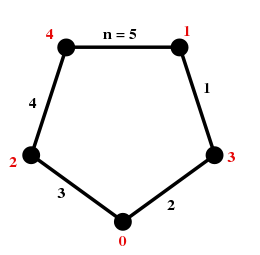Edge-graceful labeling
In graph theory, an edge-graceful graph labeling is a type of graph labeling. This is a labeling for simple graphs in which no two distinct edges connect the same two distinct vertices, no edge connects a vertex to itself, and the graph is connected. Edge-graceful labelings were first introduced by S. Lo in his seminal paper.[1]
Definition
Given a graph G, we denote the set of edges by E(G) and the vertices by V(G). Let q be the cardinality of E(G) and p be that of V(G). Once a labeling of the edges is given, a vertex u of the graph is labeled by the sum of the labels of the edges incident to it, modulo p. Or, in symbols, the induced labeling on the vertex u is given by
where V(u) is the label for the vertex and E(e) is the assigned value of an edge incident to u.
The problem is to find a labeling for the edges such that all the labels from 1 to q are used once and the induced labels on the vertices run from 0 to p − 1. In other words, the resulting set for labels of the edges should be and for the vertices.
A graph G is said to be edge-graceful if it admits an edge-graceful labeling.
Examples
Paths
Consider a path with two vertices, P2. Here the only possibility is to label the only edge in the graph 1. The induced labeling on the two vertices are both 1. So P2 is not edge-graceful.
Appending an edge and a vertex to P2 gives P3, the path with three vertices. Denote the vertices by v1, v2, and v3. Label the two edges in the following way: the edge (v1, v2) is labeled 1 and (v2, v3) labeled 2. The induced labelings on v1, v2, and v3 are then 1, 0, and 2 respectively. This is an edge-graceful labeling and so P3 is edge-graceful.
Similarly, one can check that P4 is not edge-graceful.
In general, Pm is edge-graceful when m is odd and not edge-graceful when it is even. This follows from a necessary condition for edge-gracefulness (see below).
Cycles
Consider the cycle with three vertices, C3. This is simply a triangle. One can label the edges 1, 2, and 3, and check directly that, along with the induced labeling on the vertices, this gives an edge-graceful labeling.
Similar to paths, is edge-graceful when m is odd and not when m is even.
An edge-graceful labeling of is shown in the following figure:

A necessary condition
Lo gave a necessary condition for a graph to be edge-graceful. It is that a graph with q edges and p vertices is edge graceful only if
- is congruent to modulo p.
or, in symbols,
This is referred to as Lo's condition in the literature. This follows from the fact that the sum of the labels of the vertices is twice the sum of the edges, modulo p. This is useful for disproving a graph is edge-graceful. For instance, one can apply this directly to the path and cycle examples given above.
Further selected results
- The Petersen graph is not edge-graceful.
- The star graph (a central node and m legs of length 1) is edge-graceful when m is even and not when m is odd.
- The friendship graph is edge-graceful when m is odd and not when it is even.
- Regular trees, (depth n with each non-leaf node emitting m new vertices) are edge-graceful when m is even for any value n but not edge-graceful whenever m is odd.
- The complete graph on n vertices, , is edge-graceful unless n is singly even, .
- The ladder graph is never edge-graceful.
References
- ↑ Lo (1985)
- Lo, Sheng-Ping (1985). "On edge-graceful labelings of graphs". Congressus Numerantium. 50: 231–241. Zbl 0597.05054.
- Q. Kuan, S. Lee, J. Mitchem, and A. Wang, On Edge-Graceful Unicyclic Graphs, Congressus Numerantium 61(1988) pp. 65–74
- L. Lee, S. Lee and G. Murty, On Edge-Graceful Labelings of Complete Graphs: Solutions of Lo’s Conjecture, Congressus Numerantium 62(1988) pp. 225–233
- D. Small, Regular (even) Spider Graphs are Edge-Graceful, Congressus Numerantium 74(1990) pp. 247–254
- S. Cabaniss, R. Low, J. Mitchem, On Edge-Graceful Regular Graphs and Trees, Ars Combinatoria 34(1992) pp. 129–142